Hector - Ontario, Canada
Uruk-Hai Swordsman
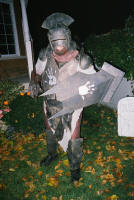 I
got the idea to start the costume at Trilogy Tuesday last year when
I observed that the costume contest didn't have any bad guys! I mean
elves and hobbits are OK but BRING ON THE ORCS! I took a look
through your site and to see what other people had done. Since I'm
not familiar with metal working and didn't have the tools for it, I
decided to go the cardboard/modge-podge route. I
got the idea to start the costume at Trilogy Tuesday last year when
I observed that the costume contest didn't have any bad guys! I mean
elves and hobbits are OK but BRING ON THE ORCS! I took a look
through your site and to see what other people had done. Since I'm
not familiar with metal working and didn't have the tools for it, I
decided to go the cardboard/modge-podge route.
I have worked on the costume since February but really most of it
was done in the last 3 months - finished for Halloween. All the armour is
cardboard & modge podge papier-mâché, painted and weathered to look like
metal. It's surprisingly strong and heavy but I can move around in it
easily. I was even up dancing at a costume party in Toronto!
Here's how I went about it...
I wanted to have the armour to have more weight and bulk than
just poster-board would give it so I used artist's canvas board.
It's a heavyweight cardboard about 1/4" thick with primed canvas
applied to it. The first image under gloves
shows the board with the outlines of the leg greaves before being
cut out. The other pieces are the sword arm vambrace that has been
cut out and formed to shape as well as spiked armour plates that
will be attached to a glove. Once I cut the piece out I gradually
bend it over my knee to form it to shape. I found that when bent
into extreme curves the cardboard layers would sometimes separate
but I forced glue between them and clamped it together. This had the
advantage of helping to hold the shape. After that I covered the
piece in several layers of modge-podge and ripped newspaper to give
it additional strength. Any points, such as the spikes on the
shield, were given several additional coats of carpenter's glue to
give them some protection against bumps. Once all of that dries
details such as rivets are added using thumbtacks. Real rivets will
be used to attach the straps and to assemble the armour but that is
after the painting.
So on to...
I experimented first with the sword and the shield to see if I
could get satisfactory results from what is just painted cardboard.
The painting recipe I came up with I think seems to have worked out
well I think. First I paint the formed and modge-podged armour a
basic black. I used what I had on hand which was some Floquil enamel
paint meant for the model railroad hobby but anything would work as
long as it formed a good bond with the armour and won't flake off
later. Next I used some of the textured granite spray paint - the
type used for faux finishes - to give the surface some texture and
to help camouflage the wrinkles in the newspaper from the
modge-podge. Another coat of black paint is applied but this time I
used a fast drying Krylon super flat black spray paint.
Caution, this stuff has seriously hazardous fumes that linger so
spray outside if you can or leave the windows open. A happy accident
was that as the spray paint dried, because it was so fast, it shrunk
a bit and crackled the surface of the paint. Just paint over any
gaps and let dry. All this texture work is to make it look like
hammered, fire-darkened and rusted metal. In order to achieve a
metallic look I used a pewter-coloured metallic paste similar to Rub
n Buff. I made up a jar of this paste thinned quite a bit with
mineral spirits or turpentine to create a metallic wash. I would dip
my brush in the wash and move it around to stir up the metallic
particles. I'd them go over the black painted piece of armour with a
heavy wash, re-dipping my brush as necessary. It will dry to a
mottled metallic finish. It's amazing the transformation that occurs
at this stage where the piece goes from OK looking but definitely
just painted cardboard to something that could almost pass as metal.
The only thing that is left is weathering and final assembly.
First I wanted to tone down the shine of the metallic finish so I
very lightly over-sprayed with the flat black paint again. I stood
farther back to just get an overall light dusting of paint. For most
of the weathering I fell back on the techniques I've used in the
past for model railroading. Mostly I used the dry-brush technique.
This involves using an older, more worn out brush, dipping it in
your paint and then on some scrap paper towel, wiping almost all of
the paint off the bristles. When you apply it to the armour only a
little bit of paint should roughly be applied. If too much is going
on, wipe it some more on the towel. In this way I built up layers of
rust and grime. I would attach any straps at this time and I would
dry brush them too to weather them. I wanted everything to have the
look of dirt, grime, rust and blood. Definitely not a pretty site!
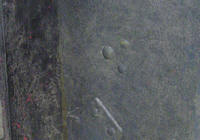 |
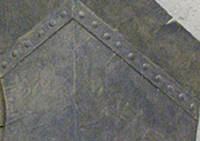 |
| Close ups on weathering |
|
All in all I'm pretty happy with how it's turning out. The only
thing I would change would be to use something other than pewter for
the metallic wash. I didn't want it too shiny which is why I chose
pewter but it gave the finished armour a brownish hue. Next time I
would pick a silver knowing I could dull it down and weather it so I
could get more of a blueish black metallic look. Oh well, I'm not
starting over at this point. Working to my advantage was that I
wanted it to look like really beat-up distressed metal I don't thing
these same techniques would work if you wanted very smooth armour -
anime armour for example - certainly not without a lot of filling
and sanding.
Here's just few notes on some of the pieces so far...
This was my first piece so I worked out the construction process
and painting recipe on it. It is basically all one piece of canvas
board, cut to shape and then scored and folded to shape. For the
angled flange at the top I made a vertical cut from the point at the
top down to the score where meets the bulk of the shield. I them
folded it out. Doing this opened up the vertical cut so I cut a
scrap piece of canvas board in a triangle shape to fit and glued it
in. This held the angle in place. Once everything was covered with
modge-podge you can't really tell that it's not all one piece. For
the spikes at the bottom I cut them out as part of the main body of
the shield and then attached identical pieces on top to create the
3-D look of a separate plate. The handle on the back is a Stanley
gate handle, padded and wrapped with leather thong. The upper arm
support is an old leather belt from the thrift store.
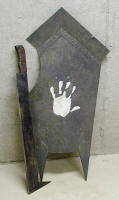 |
 |
| Another view of the finished glove.
Here you see the armour plates have been riveted directly to the
outer glove. I built in articulation when attaching the plates so
there is a bit of movement when flexing your hand. |
Back view of shield showing handle
grip and belt used for upper arm support.
|
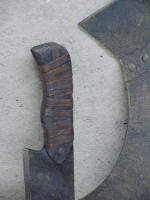 |
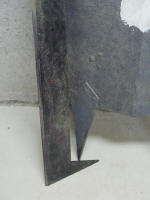 |
| Detail view of the top of the
shield and leather-wrapped hilt of the sword. All the rivets are
decorative only and made out of thumbtacks. |
Detail view of the bottom of the
shield showing the how the spikes appear like separate plates.
Again all the rivets are cosmetic only with the exception of the
large bolt head which is used to attach the handle to the shield. |
I downloaded an image of the United Cutlery Uruk-Hai Scimitar and
traced it's outline including the hilt. I them scaled up the drawing
on a photocopier to 30" in length. For this I cut 2 identical pieces
of canvas board and carefully cut an angled bevel along the blade
edge of both pieces. I then glued them back to back, smooth side
out. The 2 angled cuts created not a bad edge when put together. The
hilt was finished off with 2 pieces of wood glued and then carved to
shape.
Leather straps completed the look.
For the gloves I roughly followed some of the images on the 'net
and in the design galleries of the TTT extended edition DVD. They
are made up 2 layers of gloves. The outer are rough leather work
gloves with the fingers cut off and the inner gloves are some cool
gardening gloves I found. I thought that they weren't long enough so
I made some cuffs out of scrap leather that fit inside them. The
metal plates on the one glove is again made of painted canvas board
and then riveted directly to the outer glove.
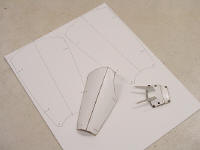 |
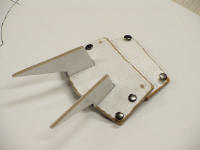 |
| Front view of the finished helmet.
It is all done in cardboard, newspaper and modge-podge over a
baseball helmet shell. It's very strong and surprisingly heavy.
The wig is (for now) attached to the inside back of the helmet.
When I wear it I'll put in fangs and apply makeup to the lower
part of my face and neck. |
Side view of the helmet. The
overall proportions are off due to using the baseball helmet as a
base but it greatly simplified construction so it's forgivable. |
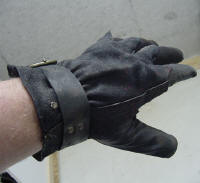 |
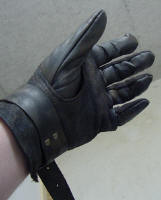 |
| The shield arm glove in progress.
It was made using a leather work glove, dyed black and the fingers
cut off. |
Another view of the glove in
progress. You can clearly see the two types of gloves that make up
the inner and outer gloves. The inner glove is a type of gardening
glove with a black vinyl no-slip material covering parts of the
thumb and fingers. Everything has been extensively weathered. |
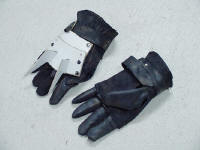 |
 |
| This shows both gloves in progress
with the spiked armour plates yet to be painted and attached. I
later made cuffs out of scrap leather to fit inside the gloves and
make them look longer. |
The finished sword arm glove
showing both the finished spiked armour plates and the leather
cuff. It has all been further distressed and weathered. At bit of
red paint for blood splatters is always good. |
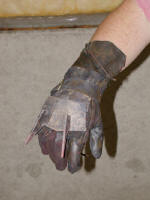 |
|
| Another view of the finished glove.
Here you see the armour plates have been riveted directly to the
outer glove. I built in articulation when attaching the plates so
there is a bit of movement when flexing your hand. |
|
This is what I thought would give me the most trouble an I
thought about it a lot. In the end it went quite easy. I got the
idea of using a baseball batting helmet as the base from the 2 women
doing Sam and Frodo in orc armour. Once I had that to build on the
rest just fell into place. I built the basic look of it using
poster-board and electrical tape. Then I bent and inserted coat
hanger wire to strengthen it and create the flare at the back.
Separate pieces of artist's mat-board formed the various plates and
the blades where made out of canvas board with a lot of filler to
get the curves. The proportions are little off but passable I
thought. For now I've attached the wig to the inside back of the
helmet as I'm not planning on wearing a mask. I've got a set of
Uruk-Hai teeth from Dental Distortions and will use makeup on the
lower part of my face and neck but the helmet covers the rest of my
head. My thought was that since the costume will be hot and heavy I
can take off the helmet and wig to get some fresh air without having
a hot prosthetic mask on. I might change this in the future so the
wig is attached with screw posts instead of rivets.
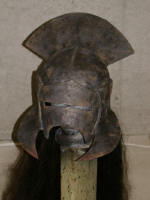 |
 |
| Front view of the finished helmet.
It is all done in cardboard, newspaper and modge-podge over a
baseball helmet shell. It's very strong and surprisingly heavy.
The wig is (for now) attached to the inside back of the helmet.
When I wear it I'll put in fangs and apply makeup to the lower
part of my face and neck. |
Side view of the helmet. The
overall proportions are off due to using the baseball helmet as a
base but it greatly simplified construction so it's forgivable |
 |
 |
| Back view of the helmet. All the
rivets are for appearances only with the exception of the six
across the back which are screw posts to hold the wig in place.
The screw posts will allow me to remove the wig if at some time in
the future I decide to go with a full-face prosthetic, in which
case I would want to wear the wig on my head. |
Close-up view showing off the
fangs. You can just make out how I was able to wear my glasses
under the helmet so I could see. In the future I'll get some
special effect contacts and re-position my head in the helmet to
bring it closer to my face. As you can see, because of the
coverage afforded by the helmet, as long as I leave it on, a
prosthetic mask is not necessary. However, this is again something
I'll look into in the future. I know most Uruk-Hai in the movies
had little if any facial hair (a hold-over from their ancient
elven heritage?) I kept my goatee as I was reluctant to shave it
off. I think it adds to the look. |
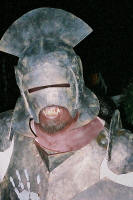 |
|
| |
|
I wore the costume for the first time at Halloween - I was working on
finishing it off right up until the last minute! I'm 6 feet tall and the
helmet visually adds at least 8 inches to that so needless to say I scared a
lot of kids (and I think quite a few of their parents, as well) - more candy
for me! Actually, it was fun. A lot of kids recognized the character and
wanted to come and see me up close to see if I was for real. I'd shake their
hand if they were brave enough. :)
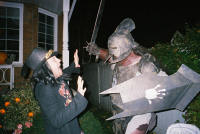 |
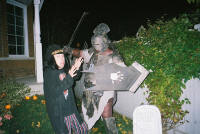 |
| This and the next 2 shots
show me clowning around with my brother but they show off the mobility
of the outfit and how I can manoeuvre in the armour. I think I'm more
than a little intimidating! |
|
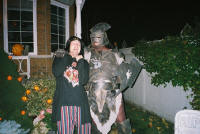 |
|
|
|

v ----- Advertisement -----v
^ -----Advertisement ----- ^

Nasties | Nasties 2 | Nasties 3 | Nasties 4
Home | Up | Chris | Hector | Janet | Jeff | Jo | Tess & Mars

This page was last updated
11/21/09
|


![]()
![]()







![]()
![]()
![]()